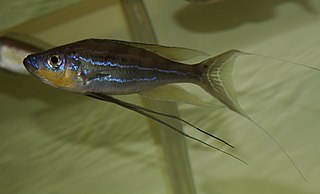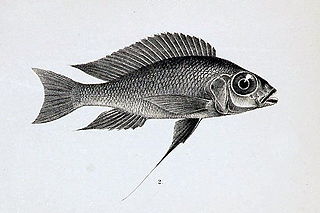Limbochromis robertsi is a species of cichlid endemic to Ghana where it is found in the upper reaches of the Pra River Basin. This species has been recorded reaching a maximum length of 10 centimetres (3.9 in) TL. It is currently the only known member of its genus. The specific name honours the American ichthyologist Tyson R. Roberts who collected the type.

Ectodus descampsii is a species of cichlid fish endemic to Lake Tanganyika in East Africa where it prefers areas with substrates of coarse sand. It feeds on micro-organisms, algae and diatoms. This species reaches a length of 10.4 centimetres (4.1 in) TL. It is also found in the aquarium trade. It is currently the only known member of its genus. The specific name honours Capitaine Georges Descamps (1855-1938), a Belgian officer in the anti-slavery movement at Lake Tanganyika.

Grammatotria lemairii is a species of cichlid endemic to Lake Tanganyika in East Africa where it prefers areas with sandy substrates. This species can reach a length of 26 centimetres (10 in) TL. It is currently the only known member of its genus. The species is occasionally kept as an aquarium fish. The specific name honours Lieutenant Charles Lemaire (1863-1925) who was the leader of the Congo Free State Expedition, which collected specimens of fishes at Lake Tanganyika, including the type of G. lemairii.
Haplochromis welcommei is a threatened species of cichlid endemic to Lake Victoria in Africa. This species reaches a length of 10.5 centimetres (4.1 in) SL. Although further surveys are needed to confirm its status, it is considered possibly extinct by the IUCN on the basis that there have been no definite records since 1985.
Aulonocara gertrudae is a species of haplochromine cichlid which is endemic to Lake Malawi, being found in Malawi, Mozambique, and Tanzania. The habitat varies between populations, those south of the Ruhuhu River are sand dwellers which exploit the sandy muddy substrates found near river mouths, while those to the north of the Ruhuhu will occupy rocky habitats too. This is thought to be cause there are fewer rock inhabiting congeners north of the Ruhuhu. The territorial males of this species excavate a burrow in the sand or they may use a cavity formed in a rocky area, especially in the northern populations. The females are found in small foraging groups in the vicinity of the males. The specific name honours Konings' wife, Gertrude Dubin.

Benthochromis tricoti is a species of fish in the cichlid family. It is endemic to Lake Tanganyika in Africa and lives at depths of up to 100 m (330 ft). It feeds on small crustaceans and plankton. It reaches a maximum length of 16.5 cm (6.5 in). Like many other cichlids, it is a mouthbrooder.

Cunningtonia longiventralis is a species of cichlid endemic to Lake Tanganyika in East Africa where it is found near rocky shores. It eats floating plankton. This species reaches a length of 14 centimetres (5.5 in) TL. It can also be found in the aquarium trade. As of 2011 it is the only known member of its genus. The generic name honours the British zoologist and anthropologist William Alfred Cunnington (1877-1958), the leader of the expedition to Lake Tanganyika during which type was collected.
Docimodus evelynae is a species of haplochromine cichlid. It is endemic to Lake Malawi; it is widespread in the lake and found in Malawi, Mozambique, and Tanzania. This species has unusual feeding habits: it feeds upon the flank scales of cichlids or cyprinids and the skin of catfishes. The specific name honours Evelyn Axelrod, the wife of the publisher Herbert R. Axelrod (1927-2017).
Placidochromis polli is a species of cichlid endemic to the southern portions of Lake Malawi where it prefers areas with muddy or sandy substrates at depths of greater than 75 metres (246 ft). This species can reach a length of 14.9 centimetres (5.9 in) SL. Its specific hame honours the Belgian ichthyologist Max Poll (1908-1991).

The damba is a species of cichlid.

The kotsovato is a species of cichlid from northwestern Madagascar. As presently defined its range spans several river basins, but this could possibly include more than one species. It is threatened by habitat loss and competition from introduced species. This relatively elongate Paretroplus reaches about 16 centimetres (6.3 in) in length and is closely related to P. gymnopreopercularis, which it resembles. The specific name honours the French fisheries scientist André Kiener.
Paretroplus nourissati, the lamena, is a species of cichlid from the vicinity of the confluence of the Amboaboa and Mangarahara Rivers near Mandritsara in northern Madagascar. This relatively elongate Paretroplus reaches about 16 centimetres (6.3 in) in length, and is closely related to P. lamenabe and P.tsimoly. P. nourissati is threatened by habitat loss and invasive species.
The kotso is a species of cichlid fish from northwestern Madagascar. Currently rated as data deficient by the IUCN, this species is virtually unknown. The only known specimen is a juvenile that was collected more than 80 years ago. It is not entirely clear where it was collected, but likely from the Maintimaso River or Lake Ambanja, which both are part of the Betsiboka River drainage. Erroneously, the name P. petiti has often been applied to members of a different species, P. dambabe. The specific name honours the French zoologist and anatomist Georges Petit (1892-1973) of the Muséum national d’Histoire naturelle, who collected type.

Ptychochromis grandidieri is a species of fish in the family Cichlidae endemic to river basins along a large part of the eastern coast of Madagascar, although it has been recorded as far as 100 km (62 mi) inland. Uniquely in the genus Ptychochromis, this species also occurs in brackish water. It reaches 35cm in standard length. It shares a large part of its range with a cichlid from another genus, Paretroplus polyactis. The specific name honours Alfred Grandidier (1836-1921), the French naturalist and explorer who, with Henri Joseph Léon Humblot (1852-1914), collected the type.
Ptychochromis loisellei is a species of cichlid from the Mahanara River basin north of Sambava in northeastern Madagascar. It remains common within its small range, but it is threatened by habitat loss and introduced species. It reaches about 11.9 centimetres (4.7 in). The similar named Paretroplus loisellei is also restricted to the Mahanara River basin. The specific name honours Paul V. Loiselle, Emeritus Curator of Freshwater Fishes at the New York Aquarium and a researcher in, and campaigner for the conservation of, the freshwater fish of Madagascar.
Katria is a genus of freshwater fish in the cichlid family. It contains the single species Katria katria, a vulnerable species from the Mangoro and Nosivolo Rivers in east-central Madagascar, that was formerly included in the genus Ptychochromoides. The only other monotypic cichlid genus in Madagascar is Oxylapia, and it is restricted to the same region as Katria. In 2010, the Nosivolo River was designated as a Ramsar Site. The Katria reaches about 13 centimetres (5.1 in) in length.
Danakilia franchettii is a species of cichlid fish endemic to the saline Lake Afrera and nearby swamps in Ethiopia. It was the only member of the genus Danakilia until the description of D. dinicolai in 2010. The species is listed as endangered, due to water abstraction and mining of salt in the lake. The specific name honours the Italian explorer Raimondo Franchetti (1889-1935), who organised, at his own expense, the expedition that collected type.
Ptychochromis ernestmagnusi is a species of fish cichlid only known from the Mananara du Nord River in northeastern Madagascar, but it is probably more widespread in that region. If so, it likely occurs in the Mananara-Nord Biosphere Reserve, which would give it a level of protection. It can reach 14.7 cm (5.8 in) in standard length. The specific name honours Ernest Magnus (1908-1983) who was the uncle of the German-American marine biologist and ichthyologist Rudolf Arndt who gave generous support to the author's research, at the request of Anrdt's family, whose “generous gift” supported the authors’ research. Magnus played an important part in assisting the Arndt family to survive in Berlin after the Second World War and then emigrate to New York City in 1950, by giving them "food, clothing, shelter, love, many kindnesses and moral support".
Paretroplus loisellei is a vulnerable species of cichlid fish from the Mahanara River basin north of Sambava in northeastern Madagascar. Until its scientific description in 2011, this population was usually referred to as Paretroplus sp. nov. "Ventitry" or included in P. damii, which it resembles. It reaches about 15 centimetres (5.9 in) in length, and is threatened by habitat loss and introduced species. The similar named Ptychochromis loisellei is also restricted to the Mahanara River basin. The specific name honours Paul V. Loiselle, Emeritus Curator of Freshwater Fishes at the New York Aquarium and a researcher in, and campaigner for the conservation of, the freshwater fish of Madagascar.

Astatotilapia bloyeti is a species of haplochromine cichlid from the coastal river systems of Tanzania. Reports from other areas of Africa are considered to refer to related species. The IUCN considers it to be endemic to the Pangani River and includes Kenya in its range. This species taxonomic status is uncertain and some authorities place it in the genus Haplochromis while others retain it in Astatotilapia. This taxonomic uncertainty has led the IUCN to classify this species conservation status as Data Deficient. The specific name honours the collector of the type, Capitaine A. Bloyet, chief of the French research station at "Kandôa, Tanzania".








